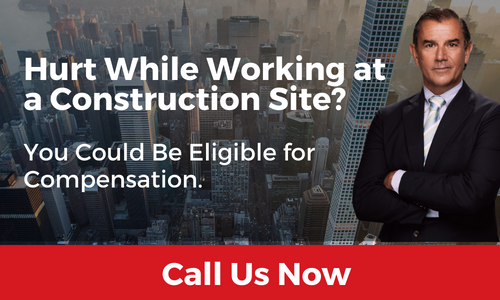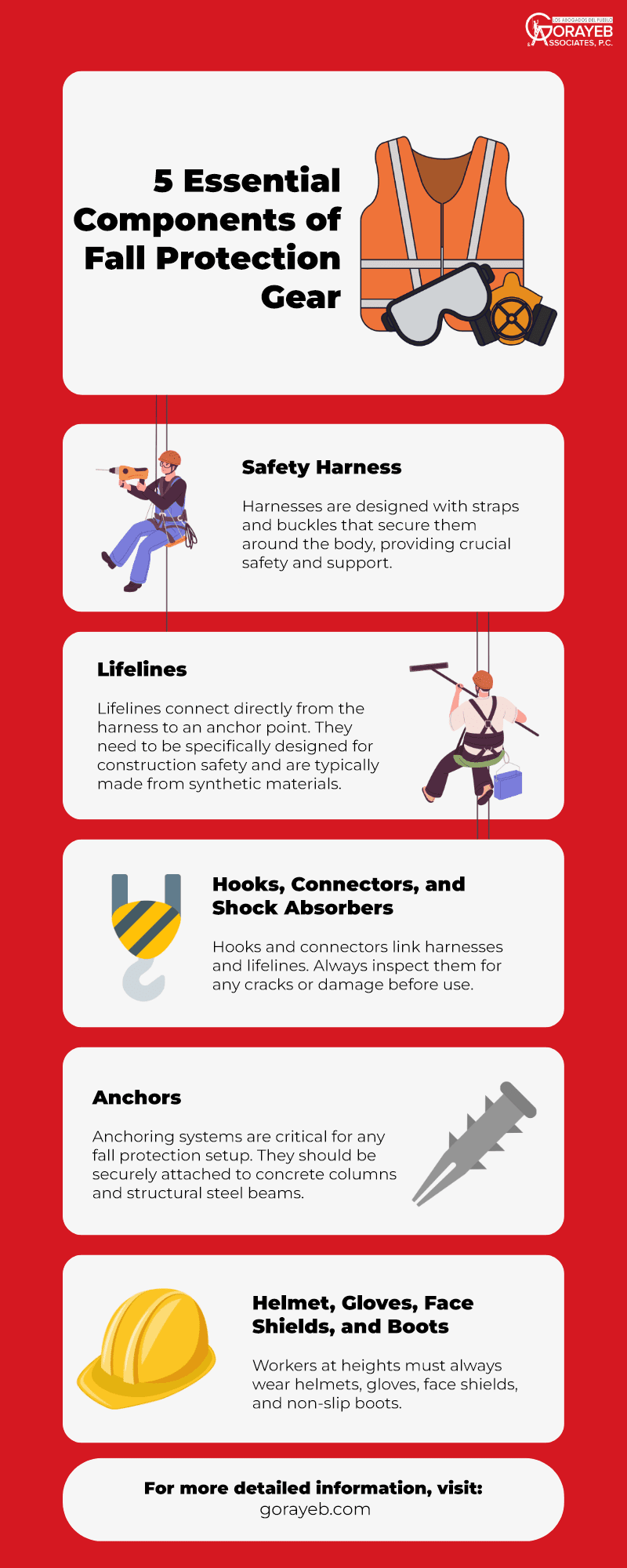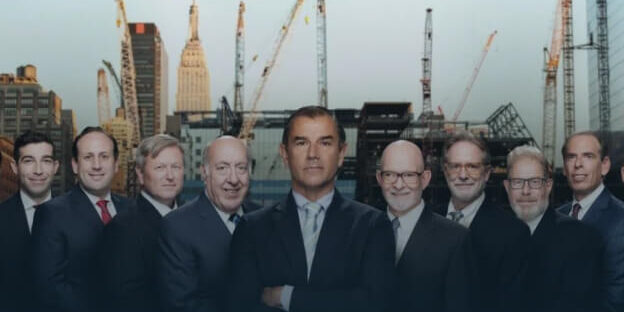Personal protective equipment consists of a series of safety elements that every worker must use when performing their tasks to prevent construction accidents.
This personal protective equipment (known in the workplace as PPE) varies depending on the specific task the worker is required to perform on the construction site. The more complex and risky the task, having the appropriate construction site safety equipment becomes more critical, as well as having precise knowledge of how to use various safety tools.
Among the most dangerous jobs in construction are those performed at heights, such as repair, maintenance, cleaning, construction, or restoration tasks that must be carried out on:
- Scaffolds
- Ladders
- Roofs
- Coverings
- Poles
- Platforms
- Heavy machinery
- Excavations
- Wells
- Rooftops
- Level changes
In general, the personal protective equipment (PPE) designed for taking safety measures for working at heights encompasses five pivotal functions published by the authoritative guidelines provided by the National Institute for Occupational Safety and Health (NIOSH):
- Prevent workplace injuries: the primary focus of PPE lies in averting workplace injuries, particularly those associated with slips and falls, potential impacts from objects, and the risk of electrocution. By providing a robust defense against these hazards, PPE acts as a frontline safeguard for workers engaged in tasks at elevated heights.
- Protect workers from exposure to toxic substances: The inherent risks of working at heights extend beyond physical injuries to potential exposure to toxic substances. PPE, in this context, acts as a barrier, shielding workers from harmful chemicals and substances that may pose health hazards during construction activities.
- Prevent the spread of infectious diseases: Recognizing the importance of maintaining a healthy work environment, PPE plays a crucial role in impeding the spread of germs among colleagues and curbing the transmission of infectious diseases. This function assumes heightened significance, particularly in construction scenarios where close collaboration among workers is inherent.
- Ensure regulatory compliance: PPE serves as a cornerstone in ensuring that companies, employers, and construction sites adhere scrupulously to the extensive regulatory framework governing personal protective equipment for work at heights. By aligning with these regulations, PPE not only safeguards individual workers but also upholds the collective commitment to maintaining a secure and compliant work environment.
- Enhance productivity and efficiency: Beyond its protective attributes, PPE contributes significantly to the augmentation of productivity and efficiency among workers engaged in tasks at elevated heights. By providing a secure and controlled working environment, PPE empowers workers to execute their duties with confidence and focus, ultimately fostering a culture of heightened productivity and operational efficiency.
5 Main Elements of Fall Protection Equipment
The elements that make up fall protection equipment for workers operating at heights include preventive accident systems that protect hands, feet, eyes, and ears, and ensure body safety in risky situations, such as slipping, losing balance, or surface failure.
1. Safety harness
Harnesses are frameworks equipped with straps and buckles that are fastened to the body with the intention of securing it. It is the basic element of fall protection. In case of emergency, the harness distributes the forces of fall arrest between the worker’s thighs and buttocks. In the past, belts were used for this purpose, but it was demonstrated that they caused internal organ injuries (especially to the pancreas and spleen) during strong impacts. Therefore, their use is now prohibited, and they have been replaced by harnesses, whose technology provides safe and resistant products.
2. Safety ropes
Safety ropes connect directly from the harness to an anchor point. They cannot be just any type of rope; they must be specifically manufactured for construction safety and are usually made of synthetic materials. Some of their components to ensure proper functioning are rings, hooks, and fixing rings. It is recommended to always use them accompanied by shock absorbers and should never have knots or tie themselves (unless expressly indicated by the manufacturer). In addition to safety ropes, there are lifelines, which are divided into two types:
-
- Vertical lifelines:
Must be able to support maximum loads of up to 5,000 pounds when used by a single worker and be tied to a fixed support capable of also supporting a 5,000-pound load. - Horizontal lifelines:
They are an extra safety reinforcement used in high-risk activities. Horizontal lifelines must be able to withstand at least double the impact of the load.
- Vertical lifelines:
3. Hooks, grips, and shock absorbers
- Hooks have the function of connecting harnesses and ropes and should be checked before use to rule out cracks or damaged surfaces. It must close tightly and not present any dents or bends. Once closed, it should not be able to open by itself.
- The function of grips is to connect safety ropes with lifelines. They have a protection mechanism that closes automatically on the lifeline when the safety rope undergoes a sudden jerk or is pulled violently. It is very important that the grips be placed in the correct direction, and for this, they have an indicator arrow.
- Shock absorbers should be placed on safety ropes (sometimes even integrated directly into them) and can reduce the load on lifelines by up to 50 percent when a sudden jerk occurs.
4. Anchors
Anchorage systems are essential elements for any fall protection system. They must be anchored primarily to columns and beams of concrete and structural steel (never to unstable or mobile structures). Anchors must be able to support a minimum weight of 5,000 pounds per worker, and there are two main types:
-
- Top anchor: Fixed to the highest part of the roof and usually stationary.
- D-shaped rings: Fixed to the roof frame and can remain there permanently.
5. Helmet, gloves, face shields, and boots
In addition to using a helmet at all times (essential to prevent serious injuries in the event of a fall or impact), workers performing construction tasks at heights must always wear gloves (as a prevention of burns on the hands due to friction against ropes), face shields (which prevent eye injuries when using tools such as torches), and non-slip boots (which provide stability to the worker at all times).
Employer Obligations Regarding PPE for Work at Heights
With the intention of preventing construction accidents, the Occupational Safety and Health Administration (OSHA) establishes a series of safety protocols that all employers are obligated to comply with.
Among the obligations that employers have towards workers regarding PPE are:
- Identify the necessary PPE for each type of activity performed at heights.
- Provide and pay for workers’ personal protective equipment (intended to minimize exposure to hazards on a construction site).
- Conduct a constant hazard assessment on construction sites to identify and control potential risks to the safety and health of workers.
- Train workers to teach them the correct use of PPE and perform tests to ensure they use it correctly.
- Properly maintain PPE to prevent damage.
- Replace defective, worn, or damaged PPE (the worker should never pay for the replacement of their equipment unless it is proven that they damaged or intentionally lost it).
- Periodically review and update the effectiveness and validity of the PPE program, as well as make necessary improvements.
What to Do in Case of a Work Accident at Heights?
Despite the strict safety measures that OSHA seeks to prevent construction accidents, unfortunately, workplace injuries occur, either because employers do not follow protection standards or due to human errors.
When a worker suffers a workplace injury, it is necessary to seek immediate medical attention and report the accident to their employer. It is also advisable to consult with an experienced workplace injury lawyer to study the case and determine the type of compensation deserved.
At Gorayeb & Associates, we boast a wealth of experience spanning 35 years, dedicated to successfully resolving cases similar to yours. Our proficient legal team, fluent in Spanish, stands prepared to navigate and manage your construction accident case, particularly focusing on instances involving a breakdown in your personal protective equipment. Your safety and legal recourse are our top priorities, and we are here to advocate for your rights and well-being.
If you or someone close to you has experienced a workplace accident at heights, it is crucial to consider the importance of safety equipment needed on elevated sites in construction work. Whether you’ve encountered a mishap or want to proactively address potential risks associated with tasks performed at elevated levels, reach out to us today. Feel free to give us a call or complete the form provided to request a complimentary consultation.







